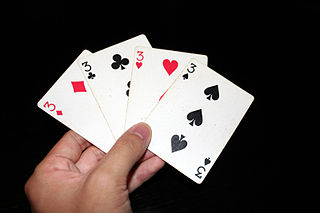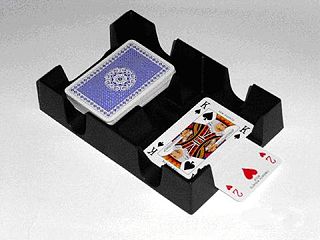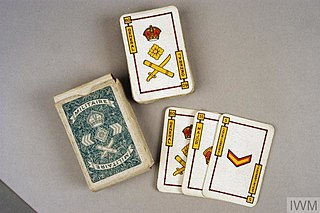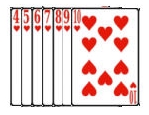 W
WRummy is a group of matching-card games notable for similar gameplay based on matching cards of the same rank or sequence and same suit. The basic goal in any form of rummy is to build melds which can be either sets or runs. If a player discards a card, making a run in the discard pile, it may not be taken up without taking all cards below the top one.
 W
WBing rummy is a variant of kalooki invented in the mining towns of Alaska. The game can be played with 2 to 8 players but works best with 3 to 6 players. It is unknown how the game came to be called “bing” although it may be because of the mining terms: unit of weight equal to 800 pounds, or a pile of rich lead ore. It is probably the second definition that gives the game its name referring to the pile of coins that accumulate throughout the game; especially as it is the Galena lead mines that popularized the term “bing ore”. These mines opened in 1919 about the time the game was developed.
 W
WBiriba is the Greek partnership version of a rummy card game of Italian origin called Pinnacola. The Greek name comes probably from the Italian game Biribara, or Biribisso, or Biribi, even if this game is totally different. It is played by two to six players, with two decks and 4 Jokers comprising 108 cards. If 6 players play, one more deck and two jokers more are added. Biriba can also be played by three players with or without partnership rules.
 W
WCarioca is a Chilean card game similar to Rummy style card games with many variations. The variation described below is Perla's Cariocas.
 W
WChinchón is a matching card game played in Spain, Uruguay, Argentina, Cape Verde and other places. It is a close variant of Gin rummy, with which it shares the same objective: making sets, groups or runs, of matching cards.
 W
WConquian, Coon Can or Colonel is a rummy-style card game. David Parlett describes it as an ancestor to all modern rummy games, and a kind of proto-gin rummy. Before the appearance of gin rummy, it was described as "an excellent game for two players, quite different from any other in its principles and requiring very close attention and a good memory to play it well".
 W
WContinental Rummy is a progressive partnership Rummy card game related to Rumino. It is considered the forerunner of the whole family of rummy games using two packs of cards as one. Its name derives from the fact that it is played throughout the continental Europe, the United States, Mexico, Canada, and also in South America. According to Albert Morehead, it was "at one time the most popular form of Rummy in women's afternoon games, until in 1950 it lost out to Canasta."
 W
WContract rummy is a Rummy card game, based on gin rummy played by 3 to 8 players. It is also known as Combination rummy, Deuces Wild Rummy, Joker rummy and Phase 10.
 W
WDesmoche is a popular rummy card game usually played for small stakes which closely resembles other games in the rummy family, like Conquian and gin rummy, more than poker. It was probably devised in Nicaragua in the first half of the 20th century.
 W
WDummy rummy is a variation of rummy for two to four players. It is played with two standard decks of cards, including four jokers, for a total of 108 cards. The jokers and twos are wild.
 W
WFour Color Cards is a game of the rummy family of card games, with a relatively long history in southern China. In Vietnam the equivalent game is known as Tứ sắc.
 W
WGerman Rummy or Rommé is the most popular form of the worldwide game, Rummy, played in Austria and Germany. It is a game for 2 to 6 players and is played with two packs of French playing cards, each comprising 52 cards and 3 jokers. There are no partnerships, every player plays for him- or herself. In Germany, the Germany Rummy Association is the umbrella organisation for local rummy clubs and organises national competitions. The game is often just known as Rommé in Germany and Rummy in Austria.
 W
WGin rummy, or simply gin, is a two-player card game variant of rummy. It has enjoyed widespread popularity as both a social and a gambling game, especially during the mid twentieth century, and remains today one of the most widely-played two-player card games.
 W
WThe term hand game is used in a number of card games, and can refer to a game where a player draws no additional cards and plays only from their hand, a game where a player uses both their own hand and that of an opponent, or a move where a player is able to play their entire hand in one turn.
 W
WMarriage, Marriage Rummy, often called 21-cards rummy, is a Rummy card game, widely played in India using three or more packs of cards.
 W
WKalooki or Kaluki, is a version of Contract Rummy popular in Jamaica, and it has become known as Jamaican Rummy. A version called "Super Kalooki" is played in tournaments while a version called "Baby Kalooki" is often played with children or for purposes of teaching the game. There are a few variations of the game described in books and on the internet. A similar game is sometimes referred to as "Kalooki 40".
 W
WKhanhoo or Kanhu is a non-partnership Chinese card game of the draw-and-discard structure. It was first recorded during the late Ming dynasty as a multi-trick taking game, a type of game that may be as old as T'ienkiu, revised in its rules and published in an authorized edition by Emperor Kao Tsung in 1130 AD for the information of his subjects. Meaning "watch the pot", it is very possibly the ancestor of all rummy games.
 W
WLiverpool rummy is a multi-player, multi-round card game similar to other variants of rummy that adds features like buying and going out. It is played the same as Contract Rummy, except that if a player manages to cut the exact number of cards required to deal the hand and leave a face-up card, then the cutting player's score is reduced by 50 points.
 W
WMilitaire was a bespoke card game of the Rummy family for three or four players in which the playing cards depicted badges of rank of the British Army. According to the Imperial War Museum it dates to the interwar period or Second World War, while other sources suggest it was made in the 1940s and 1950s. It came in two sizes: a standard size in an ordinary box and a pocket sized version in a cardboard wallet. The game is no longer manufactured.
 W
WMille is a two-player card game requiring two standard 52-card decks. Mille is a rummy game similar to canasta in the respects that if a player picks up cards from the discard pile, the player picks up the entire pile, and the only legal melds are three or more cards of a same rank.
 W
WPanguingue, Tagalog Pangginggí, also known as Pan, is a 19th-century gambling card game probably of Philippine origin similar to rummy, first described in America in 1905. It used to be particularly popular in Las Vegas and other casinos in the American southwest. Its popularity has been waning, and it is now only found in a handful of casinos in California, in house games and at online poker sites. In California, it, and the low-ball version of poker, were the only games for which it was legal to play for money.
 W
WPenang rummy or si rummy is a variant of the rummy card game that was believed to have been invented in Penang in the late 1980s and became popular in Malaysia. The word si in Penang Hokkien language means 'dead'. It reflects the nature of the card game, where the hand is dead, with no drawing of new cards or exchanging of cards, throughout the whole game. It is this feature that distinguishes Penang rummy from other rummy variants.
 W
WQuiddler is a card game and word game created by Set Enterprises. Players compete by spelling English words from cards in hands of increasing size, each card worth various points. The game combines aspects of Scrabble and gin rummy. The word "Quiddler" is a trademark.
 W
WRobbers' rummy is a card game for two or more players. It is a variant of German Rummy dating to the early 20th century. Being derived from normal rummy, it emphasises arrangement of cards based on card matching rules, while abandoning the notions of card discards and scoring entirely.
 W
WGerman Rummy or Rommé is the most popular form of the worldwide game, Rummy, played in Austria and Germany. It is a game for 2 to 6 players and is played with two packs of French playing cards, each comprising 52 cards and 3 jokers. There are no partnerships, every player plays for him- or herself. In Germany, the Germany Rummy Association is the umbrella organisation for local rummy clubs and organises national competitions. The game is often just known as Rommé in Germany and Rummy in Austria.
 W
WRumino is a knock rummy card game of Italian origin played up to 6 players in which players try to form sets or sequences of cards. It may possibly have been devised in American during the 1940s by Italian immigrants by adapting the game Scala Quaranta to Gin rummy. It is usually played for small stakes Two 52-card decks are used plus four Jokers comprising 108 cards.
 W
WRummikub [rʌmikʊb, rʌmikiub] is a tile-based game for 2 to 4 players, combining elements of the card game rummy and mahjong. There are 106 tiles in the game, including 104 numbered tiles and two jokers. Players have 14 or 16 tiles initially and take turns putting down tiles from their racks into sets of at least three, drawing a tile if they cannot play. In the Sabra version, the first player to use all their tiles scores a positive score based on the total of the other players' hands, while the losers get negative scores. An important feature of the game is that players can work with the tiles that have already been played.
 W
WShanghai rum is a Rummy card game, based on gin rummy and a variation of Contract rummy played by 3 to 8 players. It is also known as California rummy.
 W
WTen Pennies is a multi-player, multi-round Rummy-style card game involving money with possible origins in Chicago. The major features different from most Rummy-style games are the limited purchasing of additional cards (10) and the winner wins all the money used in the game. The rules and strategy are simple enough for all ages to play while still exciting and challenging for an adults only game. Playing with money is not required and anything such as chips or toothpicks may be used.
 W
WTổ tôm is a draw-and-discard card game played in Vietnam, usually by men. The game is often played at festivals. It is derived from the Chinese game of Khanhoo.
 W
WTong-its or Tongits is a 3 player rummy type of game that gained popularity in the 1990s in Luzon, the largest island of the Philippines.
 W
WTreppenrommé is a card game for two to four players, which is a variant of Rummy played in Germany and Austria. The name means "Staircase Rummy" and comes from the fact that the discard pile must be arranged such that every card is partly covered and partly visible, forming a so-called 'staircase' (Treppe). The game appears to be closely related to 500 Rum, but there are several differences.
 W
WViennese Rummy is a matching card game of the Rummy family for 2-6 people played in continental Europe.
 W
WWyatt Earp is a rummy-like card game first released in 2001. The game is named after Wyatt Earp, a famous lawman, and is set in the American Old West. It is manufactured by Rio Grande Games and was created by Mike Fitzgerald and Richard Borg for Alea.
 W
WZi Pai, are Chinese playing cards that are popular mainly in the southern part of Mainland China, especially in Hunan and Sichuan. It is also known as "Pao Fu Zi" or "Pao Hu Zhi" (跑胡子) in different dialects.